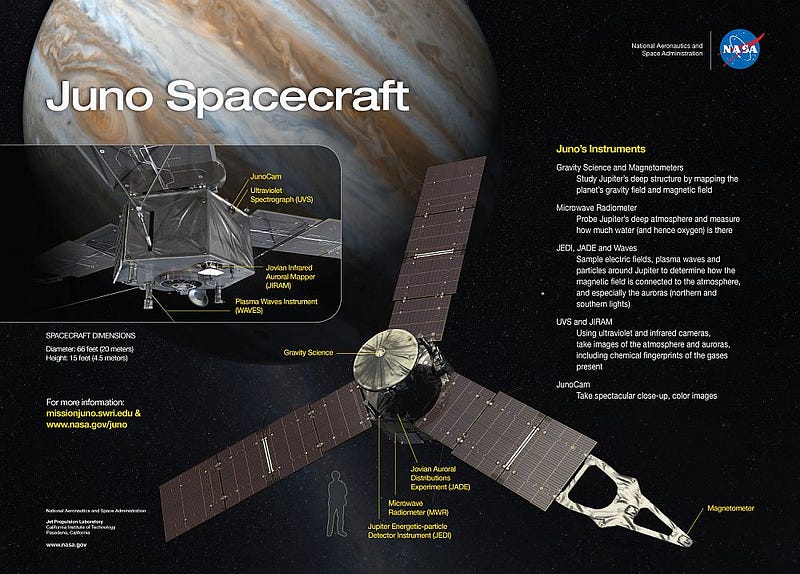Exploring the Depths of Jupiter: Juno's Extended Mission
Written on
Chapter 1: The New Era of Juno
The Juno spacecraft, a robotic explorer that has been studying Jupiter since 2016, has received an extension for its mission, allowing it to continue its groundbreaking research until at least September 2025. This extension enables Juno to delve deeper into the mysteries of the largest planet in our Solar System and its many moons, some of which, like Europa, are believed to harbor water and may be potential sites for discovering primitive life.
“Since its initial orbit in 2016, Juno has provided a wealth of information about the inner workings of this colossal gas giant. With this extended mission, we aim to resolve key questions that emerged during its primary mission while also extending our exploration to Jupiter's ring system and its Galilean moons,” states Scott Bolton from the Southwest Research Institute.
Section 1.1: A Brief History of Juno
Proposed in 2003 and launched in 2011, Juno's original goal was to investigate the formation and evolution of Jupiter. Initially scheduled to conclude in July 2021, the mission extension will now encompass 42 additional orbits around Jupiter, with close flybys of its moons Ganymede, Io, and Europa, as well as observations of the planet's polar cyclones. Notably, NASA plans to conduct the first detailed exploration of Jupiter's faint ring system.

These flybys will not only yield stunning imagery and valuable data about the moons but will also reduce Juno's orbital period, thereby increasing the total number of orbits completed.
Section 1.2: The Science of Gravity Assists
According to Ed Hirst, Juno's project manager at Jet Propulsion Laboratory (JPL), the extended mission has been meticulously designed to optimize the spacecraft's most precious resource—fuel. Gravity assists from multiple moon flybys will help navigate Juno through the Jovian system while maximizing scientific opportunities.
The satellite flybys commenced on June 7, 2021, with a close pass over Ganymede, which shortened Juno's orbital period from 53 days to 43 days. This maneuver set the stage for an encounter with Europa on September 29, 2022, further decreasing the orbital period to 38 days. Additional flybys on December 30, 2023, and February 3, 2024, will reduce the orbiting time to just 33 days, a remarkable 63% reduction from its original period.
Chapter 2: Waves from Ganymede
The extended mission has also led to exciting discoveries, including the detection of FM radio waves from Ganymede, one of Jupiter’s largest moons. These radio waves were observed in magnetic lines connecting Ganymede to Jupiter’s polar regions.
“It’s not E.T. It’s more of a natural function,” explains NASA spokesperson Patrick Wiggens regarding the phenomenon.
The radio emissions around Jupiter, first recorded in 1955, have been a subject of study for researchers for decades. The signal, detected for just five seconds as Juno sped past Ganymede at nearly 112,000 MPH, was likely generated by electrons amplifying radio waves through a process known as cyclotron maser instability (CMI). This mechanism can also produce ultraviolet auroras, which Juno has observed.
As Juno continues its mission, it will provide essential data for future explorations of Jupiter, including NASA's Europa Clipper and the European Space Agency's JUpiter ICy moons Explorer (JUICE) mission.
James Maynard is the founder and publisher of The Cosmic Companion, currently residing in Tucson with his wife Nicole and their cat, Max.
Did you enjoy this article? Join us on The Cosmic Companion Network for our podcast, weekly video series, informative newsletter, and news briefings on Amazon Alexa and more!